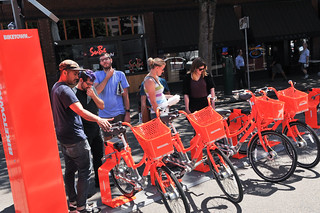We’re just going to come right out and say it: By every measure that matters, bike share in Portland is an unmitigated success (and yes we’re so confident in that statement we don’t think we’ll jinx it).
In case you missed our story yesterday about how behavioral science explains it, check out this new piece in The Oregonian where reporter Eliot Njus shares this wonderful little gem:
“The program is on-track to be self-sustaining, paying for its operations with user fees and corporate sponsorships. The transportation bureau has said the program won’t depend on city funds.”
So there’s that.
Now let’s take a closer look at the numbers behind all this great news.
Advertisement
Below are some statistics after the first month of operation followed by a list of the top 10 busiest stations (as per Portland Bureau of Transportation data between the launch date of July 19th through August 19th):
-
Number of Unique Trips: 58,834
Trips per Bike per Day: 1.90
Miles Traveled: 136,412
Average Trip Distance (Miles): 2.32
Time Ridden (Minutes): 1,706,973
Average Duration (Minutes): 29.01
Annual Members: 2,477
Single ride users: 14,397
Day Pass purchases: 6,010
% of trips by annual members: 36%
% of trips by casual users: 64%
Top 10 Biketown stations (and number of total rentals):
- 1) SW Salmon at Waterfront Park – 5332
2) SW Moody at Aerial Tram Terminal – 2753
3) SW River at Montgomery – 2631
4) SW 3rd at Ankeny – 2543
5) SW 2nd at Pine – 2466
6) NW Couch at 11th – 2448
7) SW 5th at Morrison – 2290
8) SW Naito at Ankeny Plaza- 2248
9) NW 13th at Marshall – 2173
10) NW Flanders at 14th – 2156
A few thoughts about these stats:
– The revenue from annual memberships ($297,240), day passes ($72,120), and single ride passes ($35,993) is $405,353. That doesn’t include overage charges and other fees (which is likely a very significant amount) and it doesn’t include group and corporate memberships.
– Hello Waterfront Park! Three of the busiest stations are as close to Waterfront Park as you can get. This isn’t a surprise. PBOT has also said that according to GPS data, Waterfront Park is the most popular place to ride. Remember back in April when we reported that the Portland Parks Bureau didn’t allow stations in the park itself? They felt like there was not enough room in the 30-acres between Riverplace Marina and the Steel Bridge fit them (even though there’s a full-blown bike rental shop at Salmon Street Fountain — the busiest location in the park). We can’t help but wonder if, given the popularity and success of Biketown, the Parks Bureau will change its tune. (Thanks to Jessica Roberts for pointing this out to us.)
– Trips-per-bike is a key metric. Ours is 1.9. Not bad at all for a new system, but there’s room to grow. And in the long run it must. Research shows that trips-per-bike rise as station density increases. This is because when it comes to bike share, convenience is the #1 factor in whether or not people use it (according to a 2013 survey of CitiBike users in New York City).
By way of comparison, trips-per-bike on New York City’s CitiBike system is 5.2 and it’s 3.8 on Chicago’s Divvy. Those systems have 23 and 8 stations per square mile respectively. On the other end of the spectrum, NiceRide in Minnesota has 1.4 trips-per-bike with just four stations per square mile. Portland’s system has about 12 stations per mile.
– Casual versus annual: So far it’s a 64/36 split in terms of casual users (day-trippers and single trip riders) versus annual members. This proportion is likely to change a lot when skies turn wet and cold. Right now tourists and spontaneous users are buoying the system, but those rides won’t be as common when the weather is bad. However, because the Biketown bikes are excellent all-weather machines due to their lights, fenders, durable drivetrain, and safe, upright position — it’s likely that the number of people who use them for commuting will rise.
– East versus west: You’ll note that all of the busiest stations are on the west side. This isn’t a surprise given the aforementioned points about the importance of station density (it’s 19 stations per mile on the west side, and just nine stations per mile on the east side) and the user types mentioned above (tourists and opportunists versus commuters).
What jumps out at you with these stats?
— Jonathan Maus, (503) 706-8804 – jonathan@bikeportland.org
BikePortland is supported by the community (that means you!). Please become a subsriber today. You can also make a one-time donation here.



